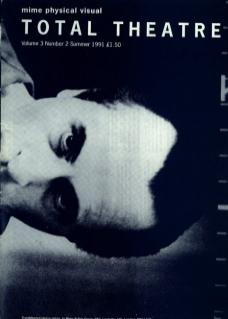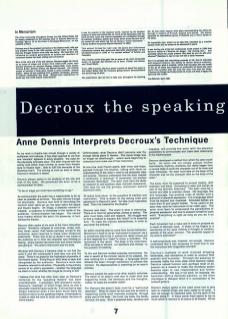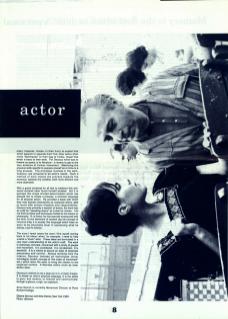As my work in theatre has moved through a variety of audiences and cultures, it has often seemed to me that one 'constant’ appears in every situation: the need for the physically articulate actor. The actor imbued with the acting craft which frees him/her to move from theatre style to theatre style, able to fulfil the demands of the theatrical event. The training of such an actor is where Decroux's research is based.
Decroux always spoke to his students of the role and task of the actor. He perceived the actor to be a communicator of ideas:
‘To be on stage you must have something to say.’
As communicator the actor has a responsibility to be as clear as possible at all times. The actor informs through his physicality. Decroux was fond of describing the moment when lights go up, the actor takes the space and theatre begins. An image, a dramatic moment is created; a response is immediate in the minds of the audience. Communication has begun. You cannot have theatre without the actor; his presence, in fact, defines the theatre.
Decroux often spoke of his work at the Vieux Columbier school. Students, stripped of costumes, props, text, their faces veiled, their backs perhaps turned to the audience, were required to make clear theatrical statements. There was to be no doubt in the minds of the audience as to what the character was thinking or feeling, where he/she had come from and where he/she was going to. The actor's instrument was the body.
Working with Decroux it became clear to me that the actor's and the mime/actor's task was one and the same. There is no place for the haphazard physicality of the theatre space. Everything an actor does is seen and interpreted by the audience. Decroux's work was therefore relevant to all actors. Physicality is the primary source of an actor's expression – whether the language be silent or vocal, whether the image be moving or still.
I believe that what has often been seen as Decroux's contempt for the ‘speaking theatre’ has been misinterpreted. I remember, with wonderful clarity, Decroux's ‘readings’ of Victor Hugo, done as only a physically masterful actor could do. It is true that he was always saddened when a fine actor would leave his studios to return to the speaking theatre, uninterested or unable to take the time to study and master the form of mime theatre.
Unfortunately, what Decroux didn't perceive was the change taking place in theatre. The visual image was no longer an afterthought – actors were beginning to understand and make use of their instrument.
At one time most French actors, both minor and major, passed through his studios, taking with them an understanding of the actor's need to be physically clear and precise. Decroux understood that the actor needed a vocabulary, a ‘grammar’ of movement, not another movement ‘technique’. The actor must have the ability to respond to and produce clear dramatic statements. This was for me the primary motivation behind Decroux's work.
All actors must return to the questions of intention and motivation. This is basic to the acting craft and paramount in Decroux's work. ‘An idea must materialise itself. Then it is material for the theatre.’
Decroux was clear. The event is what is interesting. There is no room for generalities, cliches or pathos. The actor must listen, react and respond. His struggle was to find a method to express this ‘event’ in its essential form. ‘To make the ordinary extraordinary, in order to see better the ordinary.’
An action must be seen to come from human behaviour. Movement in itself is not an ‘instrument to express’ (as it is sometimes said to be in dance) but rather comes out of and responds to a ‘need’ to move, a motivation. The movement is the result. The body is the instrument. What we keep or discard – our decisions and choices – is the question of creativity.
To this end Decroux studied everyday occurrences. He was in search of the intrinsic nature of his subjects. He was looking for a methodology, a language which allowed the actor, through movement, to achieve this moment. He depersonalised it, searching for an actor's process.
Decroux wanted the actor to be alive, explicit, articulate. The basis of an actor's craft was to make what was happening inside, the emotions and the thoughts, visible: ‘to make the invisible visible’.
For Decroux the actor's body must be a ‘well-tuned resonator’. What he meant by this was that all which is happening inside must resonate outwards, through every part of the body – the trunk, the limbs, the hands, the face, the eyes. Such a prepared body, sensitive and capable, will provide the actor with the physical possibilities to communicate and make clear statements in the theatre space.
Decroux developed a method from which the actor could build. An actor did not simply project his/her mannerisms, rhythms, charisma, but rather began from a neutral state to build the character out of its inner and outer influences. ‘An actor must take on the body of the character and not the character take on the body of the actor.’
The body must be prepared to project clearly, with precision and detail. Everything is seen and serves as part of the dramatic statement. The actor must be in control and able to exercise choice. His language, like any language, has precise rules of diction and a grammar of physical expression. It is a language which must be learned and mastered. Articulate bodies are more than fit and playful bodies. To be useful to the actor they must be instruments to be relied upon. The actor must learn to understand the possibilities of physical expression and how to prepare himself for such work. ‘Everything is right as long as you do it on purpose.’
Each movement has a value and is done on purpose as a result of dramatic need. A flicker of the fingers or a wandering of the eyes reflects a thought or emotion specific to the given moment. ‘The essential aspect of my work is articulation.’
A well-tuned body was, however, not enough. Decroux understood that it was necessary to know how to use this instrument with imagination and skill.
Decroux's methods of work involved stripping believable, real characters in order to uncover their passion and humanity. Through the essence of everyday reality the inner state could become visible. Decroux valued humour and, perhaps most of all, passion as a means to make the mundane action become open to new interpretation and further understanding. We see in his work, for example, the hesitation before declared passion, or the inner monologue or dialogue which is in contradiction to the outward gesture.
Decroux always spoke of the need mime had to give spirit to material things and carry reality to its ends. It was not enough ‘to represent work, but the spirit of the person doing it’. In these words there seems to me so much which is relevant to all actors of all theatre. All too often, however, mimes, in their hurry to exploit that which appears to separate them from other actors (their mime ‘techniques’ or their bag of tricks), forget that which is basic to their work. For Decroux mime was to theatre as poetry is to literature – a means to get to the very essence of human movement. Mastering the physical skills specific to express oneself as a mime is a long process. The principles involved in the work, however, are universal to all actors' needs. Such a method of work makes the process towards the essential, towards the credible, both more efficient and more attainable.
With a grand contempt for all that is mediocre this antisocial socialist often found himself isolated. But it is perhaps this single minded determination which has allowed him to create a process, a common language for all physical actors. He provided a basis with which they may express themselves as corporeal actors, able to move with artistic freedom and responsibility. Decroux was primarily a teacher of actors, his work was as valid for ‘speaking actors’ as it was for mimes. I do not find his ideas and techniques limited to his theatre or philosophy. If, at times, he has seemed enamoured with the form, to the detriment of content (e.g. his concept of l'homme d'ile) it is exactly this language which frees an actor to be physically clear in expressing what he wishes, how he wishes.
The more I teach actors the more I find myself coming back to his ideas: when, for example, I need to help unstick a ‘stuck’ actor. These ideas are formulated in a very clear understanding of the actor's craft. The work is extremely concrete, concerned with a study of people and movement. It is uncluttered. It is not abstract. It is essential. It is a means to assure an actor of corporeal awareness and control. Always working from the interior, Decroux insisted on techniques (inner monologue, breath, concept of ‘the motor of movement’, etc) which allow the actor to bring the interior to the corporeal surface. It liberates actors as much as clear diction does.
Decroux's method is not a style nor is it, in itself, theatre. It is simply an actor's physical language. It is the ability to give, and receive, to interact and communicate, through a glance, a sigh, an explosion.
Anne Dennis is currently Movement Director at Rose Bruford College.


